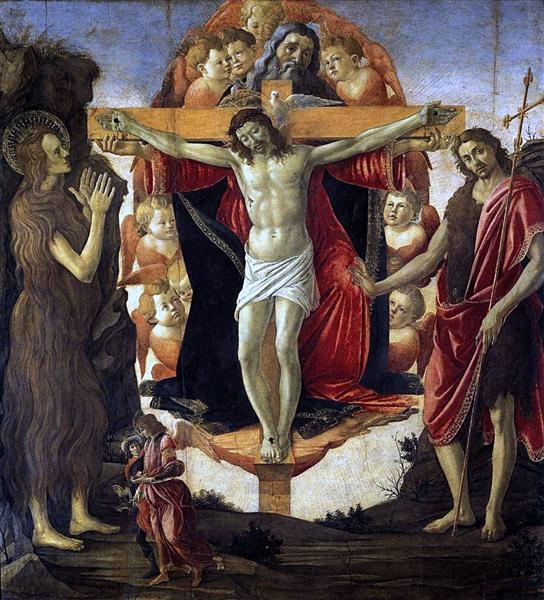Beschreibung
Die Arbeit "Trinidad - 1491" von Sandro Botticelli ist eine entscheidende Manifestation der italienischen Renaissance, eine Zeit, die durch die Verschmelzung der Spiritualität mit der Erforschung des Menschen und der Natur gekennzeichnet ist. Botticelli, bekannt für seinen eleganten Stil und seine Fähigkeit, menschliche Figuren zu repräsentieren der Heilige Geist.
Die Zusammensetzung der Arbeit ist bemerkenswert für ihre Symmetrie und sein Gleichgewicht, bei der die Charaktere in einen praktisch dreieckigen Raum unterteilt werden, was die Idee der Dreifaltigkeit verstärkt. In der Mitte gibt es die Figur des gekreuzigten Christus, eine bewegende Darstellung, die sowohl Leiden als auch Würde ausgibt. Die Figur Christi ist subtil modelliert und ist vom Gott, dem Vater und dem Heiligen Geist, umgeben, die in einem visuellen Dialog dargestellt sind, der den Betrachter einlädt, die göttliche Beziehung zwischen ihnen zu betrachten. Diese Bestimmung in Zahlenschichten verstärkt auch die trinitäre Frage und nutzt die räumliche Tiefe der Tabelle, um ein Gefühl der Hierarchie und Ehrfurcht zu erzeugen.
Die Verwendung von Farbe in "Trinidad" ist absichtlich und bedeutend. Botticelli verwendet eine Erdpalette, die von braunen und goldenen Tönen dominiert wird, was ein Gefühl der Feierlichkeit hervorruft. Die Kontraste zwischen dem hellen und dem dunklen Hintergrund unterstreichen die Figuren, während die Halos, die die göttlichen Elemente umgeben, eine Nuance der Leuchtkraft und Transzendenz zur Szene verleihen. Diese Farbaufmerksamkeit macht Farbe nicht nur visuell schockierend, sondern auch emotional resonant.
Zu den interessantesten Eigenschaften dieser Arbeit gehört der Ausdruck seiner Charaktere. Während das Gesicht Christi eine Mischung aus Schmerz und Frieden widerspiegelt, zeigt der Vater einen ruhigen Ausdruck, der sich mit dem Drama der Kreuzigung im Gegensatz zueinander verbindet. Der Heilige Geist, der oft als Taube in der christlichen Ikonographie dargestellt wird, schmückt hier eine abstraktere und symbolischere Darstellung, die den spirituellen Charakter des Augenblicks unterstreicht.
Botticelli, der von den neoplatonischen Ideen seiner Zeit tief beeinflusst wurde, veranlasst die Arbeit mit einem symbolischen Reichtum. Die Darstellung beschränkt sich nicht auf externes Erscheinungsbild, sondern lädt den Betrachter zu einer tieferen Reflexion über die Geheimnisse des Glaubens ein. Dieser philosophische und spirituelle Ansatz ist charakteristisch für viele seiner Werke, wie auch in "The Birth of Venus" und "Spring" zu sehen ist, wo die menschliche Figur nicht nur in ihrer Form, sondern auch in ihrer Bedeutung und Wesen untersucht wird.
Die Arbeit "Trinidad - 1491" ist zwar weniger berühmt als einige seiner bekanntesten Kreationen, ist eine reiche und bedeutende Erforschung des göttlichen Konzepts, das zeigt übertrifft die Zeit. Dieses Bild lädt uns ein, über die ewigen Mysterien des Glaubens nachzudenken und die Rolle der Kunst als Brücke zwischen Mensch und Göttlich zu betrachten, ein Vermächtnis, das Botticelli in der Geschichte der Kunst hinterlassen hat.
KUADROS ©, eine berühmte Farbe an Ihrer Wand.
Handgemachte Ölgemälde, mit der Qualität professioneller Künstler und dem unverwechselbaren Siegel von KUADROS ©.
Pictures Reproduction Service mit Zufriedenheitsgarantie. Wenn Sie mit der Nachbildung Ihres Gemäldes nicht vollständig zufrieden sind, erstatten wir Ihr Geld zu 100%.

